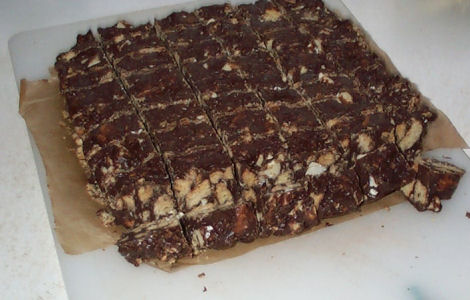Chocolate Biscuit Cake

This is known in my family as Evil Biscuit Cake. Rather heavy on calories!
Ingredients
digestive biscuits
butter
dark chocolate
white chocolate
a tin of sweetened condensed milk ()
| |
Equipment
saucepan
2 bowls
spoon
square baking tin
baking paper (optional)
knife
| |
preparation time:
break up biscuits
melt chocolate and butter
mixing ingredients
several hours setting in fridge
| |
|
Cooking process
- Break up the in a big bowl. The pieces should be fairly small, but you don't want them pulverised. I find this easiest by hand (usually watching TV!)
- Put some water in the saucepan and put another bowl in the water. Don't put too much water in; it should reach about half way up. Break up the dark chocolate, and roughly cut up the butter, and put it in the bowl. . (Making the chocolate and butter into small pieces speeds this process). Take it off the heat immediately everything is melted. Add the and stir.
- Pour and scrape the chocolate mix on top of the biscuit bits. Mix. Chop the white chocolate into small pieces. Mix them in as well.
- Line the baking tin with baking parchment. This is optional, but will help you lift out the biscuit cake when cooked. (You can do this while the chocolate is melting).
- Turn the mix into the tin. Do this a spoon at a time; this mix isn't very easy to push around. Try to get it into the corners and smoothish on top.
- Put in fridge until hard. This will be several hours; I tend to leave it overnight.
- Lift out the biscuit cake and peel off the paper. Cut the biscuit cake into small pieces. These are usually cut into quite large pieces, but I prefer small pieces, and let people eat several at a time if they want.
- If you are storing it, put it in layers with some greaseproof paper between each layer, or it will stick together. I use the baking paper that lined the tin. It's probably best to store it in the fridge as it gets sticky quite easily otherwise.
Other ideas
- You really must use dark chocolate for this. Milk chocolate doesn't melt as well, and anyway, dark chocolate is often of a better quality. I use Fair Trade chocolate. The white chocolate is really optional, but those nuggets of hard white chocolate make a lovely contrast to the biscuit. The amounts of chocolate can vary. I have used the same amount of white and dark chocolate, but the total amount should be about the same.
- Sweetened condensed milk is a very specific ingredient. If you can't find it, don't use this recipe. It is thick and very sweet. Other types of tinned milk or any form of cream probably won't work.
- Digestives are a specific type of British biscuit. Graham crackers (from America) would work as well, I suspect. You can also use ginger nuts (another type of British biscuit) or any other biscuit or cookie which is quite hard and crisp and, preferably, has some taste.
Smaller version
I had a little problem with this at one point, as it ended up too sloppy. While it is liquid at the start, all the ingredients set, or are solid, apart from the condensed milk. The problem was that I used a whole tin of condensed milk, but was using less of the other ingredients. This is a recipe where I tend to buy packs of this or that, and they might not fit in with the amounts above. I've now found a collection of amounts which are easy for me to buy, and seems to work. This is metric only, as these are the pack sizes that I buy.
A pack of shortbread fingers - 210 gms
A bar of dark chocolate - 150 gms
Half a bar of white chocolate - 75 gms
3 oz butter (yes, I know! I measure in Imperial!)
2/3 tin of condensed milk
And what do I do with the remaining half bar of white chocolate and a third of a tin of condensed milk? Eat it, of course!
Shortbread seems to work as well as digestive biscuits and you can buy them in smaller packset.
© Jo Edkins 2007 -

